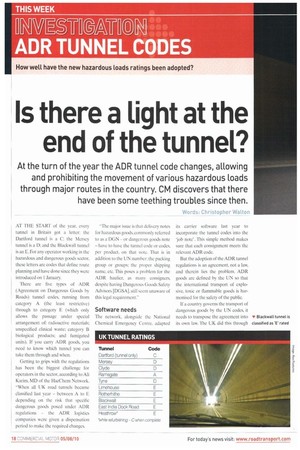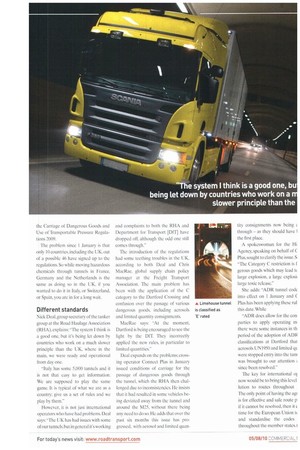Is there a Light at the end of the tunnel?
Page 18

Page 19

If you've noticed an error in this article please click here to report it so we can fix it.
At the turn of the year the ADR tunnel code changes, allowing and prohibiting the movement of various hazardous loads through major routes in the country. CM discovers that there have been some teething troubles since then.
Words: Christopher Walton AT THE START of the year, every tunnel in Britain got a letter: the Dartford tunnel is a C: the Mersey tunnel is a D: and the Blackwall tunnel is an E. For any operator working in the hazardous and dangerous goods sector. these letters are codes that define route planning and have done since they were introduced on 1 January.
There are five types of ADR (Agreement on Dangerous Goods by Roads) tunnel codes. running from category A (the least restrictive) through to category E (which only allows the passage under special arrangement of: radioactive materials; unspecified clinical waste; category B biological products; and fumigated units). If you carry ADR goods, you need to know which tunnel you can take them through and when.
Getting to grips with the regulations has been the biggest challenge for operators in the sector, according to Ali Karim. MD of the HazChem Network. "When all UK road tunnels became classified last year between A to E depending on the risk that specific dangerous goods posed under ADR regulations the ADR logistics companies were given a dispensation period to make the required changes.
"The major issue is that delivery notes for hazardous goods, commonly referred to as a DGN or dangerous goods note have to have the tunnel code or codes. per product, on that note. That is in addition to the UN number: the packing group or groups; the proper shipping name, etc. This poses a problem for the ADR haulier, as many consigners, despite having Dangerous Goods Safety Advisors [DGSA], still seem unaware of this legal requirement."
Software needs
The network. alongside the National Chemical Emergency Centre. adapted its carrier software last year to incorporate the tunnel codes into the job note'. This simple method makes sure that each consignment meets the relevant ADR code.
But the adoption of the ADR tunnel regulations is an agreement. not a law, and therein lies the problem. ADR goods arc defined by the UN so that the international transport of explo sive. toxic or flammable goods is har monised for the safety of the public.
If a country governs the transport of
dangerous goods by the UN codes, it needs to transpose the agreement into V Blackwall tunnel is
its own law. The UK did this through classified as 'E' rated the Carriage of Dangerous Goods and Use of Transportable Pressure Regulations 2009.
The problem since 1 January is that only 10 countries. including the UK. out of a possible 46 have signed up to the regulations. So while moving hazardous chemicals through tunnels in France. Germany and the Netherlands is the same as doing so in the UK, if you wanted to do it in Italy, or Switzerland, or Spain. you arc in for a long wait.
Different standards
Nick Deal.group secretary of the tanker group at the Road Haulage Association (RHA),explains:"The system I think is a good one, but it's being let down by countries who work on a much slower principle than the UK, where in the main, we were ready and operational from day one.
"Italy has some 5,000 tunnels and it is not that easy to get information. We are supposed to play the same game. It is typical of what we are as a country; give us a set of rules and we play by them."
However, it is not just international operators who have had problems. Deal says: "The UK has had issues with some of our tunnels, but in general it's working and complaints to both the RHA and Department for Transport IDfT1 have dropped off, although the odd one still conies through."
The introduction of the regulations had some teething troubles in the UK, according to both Deal and Chris MacRae. global supply chain policy manager at the Freight Transport Association. The main problem has been with the application of the C category to the Dartford C'rossing and confusion over the passage of various dangerous goods, including aerosols and limited quantity consignments.
MacRae says: "At the moment. Dartford is being encouraged to see the light by the DfT. They incorrectly applied the new rules, in particular to limited quantities."
Deal expands on the problems; crossing operator Connect Plus in January issued conditions of carriage for the passage of dangerous goods through the tunnel, which the RHA then challenged due to inconsistencies. He insists that it had resulted in some vehicles being deviated away from the tunnel and around the M25, without there being any need to do so. He adds that over the past six months this issue has progressed, with aerosol and limited quan tit y consignments now being k through — as they should have I the first place.
A spokeswoman for the Hi Agency, speaking on behalf of C Plus. sought to clarify the issue. S "The Category C restriction is f gerous goods which may lead tc large explosion, a large explosil large toxic release."
She adds: "ADR tunnel code into effect on 1 January and ( Plus has been applying these rul this date. While "ADR does allow for the con parties to apply operating rn. there were some instances in th period of the adoption of ADP classilications at Dartford that aerosols UN1950 and limited (IL were stopped entry into the turn was brought to our attention ; since been resolved."
The key for international or now would be to bring this level lotion to routes throughout The only point of having the agi is for effective and safe route p if it cannot be resolved, then it c time for the European Union tt and standardise the codes throughout the member states. I
























































































































